Darlington: Since it opened with NASCAR in 1950, things have changed just a little: Jim Hunter's Take
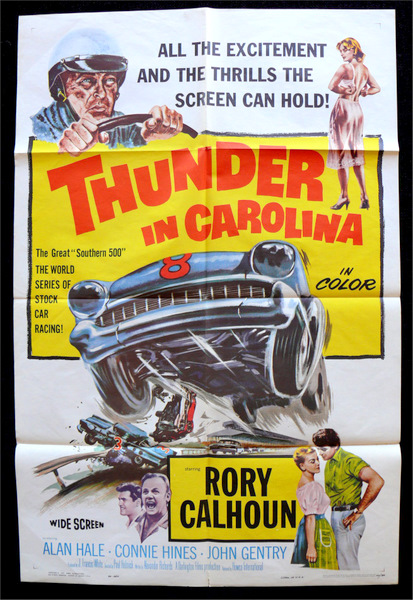
Okay, maybe it's not the definitive stock car racing movie, but, hey, it's Darlington Raceway at its finest, circa 1959 (Photo: Darlington)
By Mike Mulhern
mikemulhern.net
DARLINGTON, S.C.
That fat-boy/frat-boy pewter beer keg, full-size, over in the basement corner of the old west-side press box here at Darlington Raceway, was a legendary fixture on the NASCAR circuit for years, back in the '50s and '60s and '70s.
Maybe it belongs in that new Hall of Fame over in Charlotte....
"Falstaff," Jim Hunter recalls...with a grin.
"Down in the dungeon....where we'd all go to file our stories after the race. No windows....and everybody smoked. You'd have to turn on a 500 HP fan to blow the smoke out of that place."
Ah, the good ol' days of stock car racing. And Hunter is one of the few around who still remembers.
Plastic cups, beer on tap, cigarettes by the carton.....It used to be easy to draw a media crowd to NASCAR races....
Hunter used to run this place. And he used to run Talladega.
Before all that he was a real, honest-to-gosh newspaper reporter for the Columbia (S.C.) State. And he was here that day when Earl Balmer gave reporters quite the thrill when his crashing stock car bounced up on the guardrail at the end of the frontstretch, and the bottom ripped open, and his flying stock car sprayed gasoline and shrapnel through the chicken-wire front window of the press box. (Fortunately no one was playing with lighted cigarettes at the moment.)
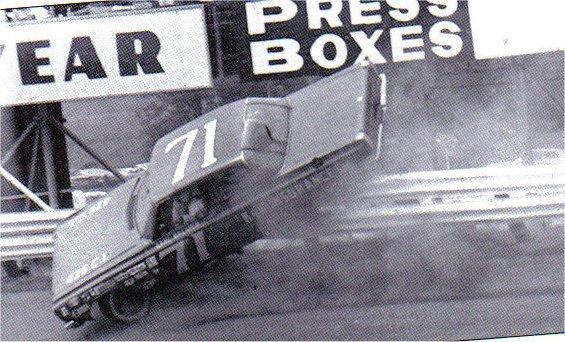
Earl Balmer gives the boys in the press box quite a thrill (Photo: NASCAR)
Crash helmets for reporters were optional, but....
"Here's how much things have changed," Hunter says. "When I first came to this track, as a reporter for the Columbia newspaper, I stopped to get my credentials, and they gave me a cushion and a pair of goggles and a box lunch.
"I asked 'What are the goggles for?' They said 'You'll see.'
"Well, the press box was like a chicken coop. Wooden benches. The goggles were for the dust and stuff that flew up in your eyes. You'd take the goggles off at the end of the race, and your face was black except for where the goggles were."
Back in the day, there were Western Union teletype machines in the back of the press box....then those ungainly 'telecopiers' that took six minutes a page to transmit race stories, which writers had to type on real typewriters.
But now it's the laptop/Internet age, and man have things changed.

Jim Hunter: He's seen a lot of changes in this sport over the years (Photo: Getty Images for NASCAR)
"Back then, the PR guy was also the marketing guy, the advertising guy, and the promotions guy back when we first started," Hunter said. "I'd have to do radio commercials, and write TV spots, and drive around the country nailing up posters...and walk through ditches to get to the fences, and get sandspurs all over me....."
Today Hunter is the France family's communications boss --- and sometimes considered the family's consigliere, the counselor who can offer judicious advice in tough situations...and a man who is often shoved out front of the media to take the heat when something goes awry.
At the moment Hunter trying his hands at all that new 'social media' stuff, Twitter and Facebook and all, getting some help from Juan Pablo Montoya and Jimmie Johnson.
And Hunter is also battling cancer: "In remission for three months now. Just got a full CAT scan.....I feel good, though my appetite isn't what I want it to be, and my energy level isn't what I want it to be. But I'm just happy to be here."
This particular afternoon, Darlington-hot, with humidity rolling over from the coast, Hunter and some old, old buddies are chewing the fat about those good ol' days and curiosities like those vintage press box beer kegs, while awaiting the start of another Southern 500.
No, back then it didn't take much to gather a crowd of newspaper journalists from real city newspapers to come cover this sport. But, my, how times have changed, Hunter concedes: today media centers around the NASCAR tour are filled so with so many 'who's they?' because newspapers, real newspapers with hardcore beat reporters, are pretty much fading into the history books....and TV, well, that crowd tends to hang around its own 'country-club' compound rather than socialize with the hoi polloi.
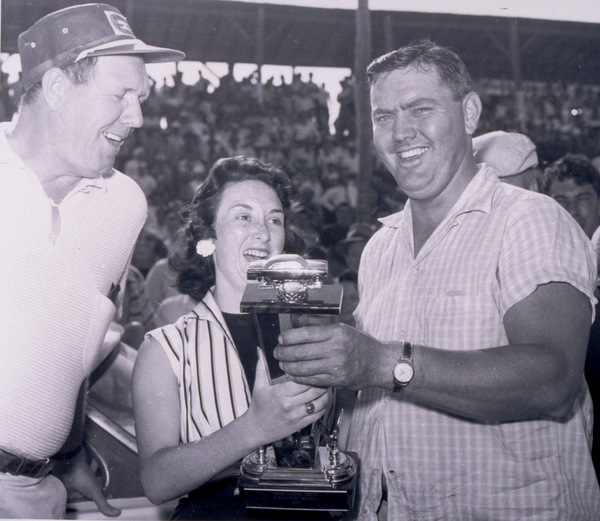
When men were men....Big Bill France (L) congratulates Junior Johnson on winning at North Wilkesboro Speedway (Photo: NASCAR)
The sport of NASCAR racing has always been as much about saturation marketing and cultural promotion as about the Sunday races themselves.
Consider just the Hollywood angle: Days of Thunder, Talladega Nights, (whatever happened to that Britney Spears NASCAR movie anyway?), Pixar's animated Cars, Kenny Rogers' Six Pack, Richard Pryor's Greased Lightning, Stroker Ace, Redline 7000, Jeff Bridges' Last American Hero, The Richard Petty Story ('Keep your RPMs up,' as Lee told Richard...)....Thunder in Carolina.
Then consider the TV angles: like Carl Edwards on Ellen DeGeneres, and Jeff Burton on General Hospital.
And of course some of those Dale Earnhardt Jr. Hollywood angles and various music videos (Nickelback, Sheryl Crow).
There is a lot more to this sport than just those 3-1/2 hours of asphalt action.
Always has been.
Saturation marketing. Overwhelming. Okay, sometimes shamelessly in-your-face.
But it's worked.
Uh, Kasey, are you sure that thing is just loaded with paint? (Photo: Getty Images for NASCAR)
Still, when newspapers began that sudden and precipitous decline a few years ago, cutting reporters, cutting beats, and generally going through some weird death-spiral dance, it came as a shock to the NASCAR world, which for so many years had depended on print reporters to promote the sport and help sell tickets.
Now it's up to TV and the Wild West internet and NASCAR's own saturation branding.
The changing face of NASCAR-and-the-media over the years is interesting:
When Darlington Raceway opened in 1950, TV was still a novelty, and newspapers were king.
"Newspaper really helped build this sport," Hunter says. "There wasn't any TV to speak of. Radio didn't really give a hoot.
"Newspapers, thank goodness, carried stories and results....and even had beat writers, especially in the Carolinas....and helped legitimize the sport, even though it was still primarily in the Southeast.
"Here's another example of how much coverage has changed: back in the day, you would write your stories on a typewriter, with carbon paper – so, after you handed your story to the Western Union operator, if they lost it, you'd have a backup copy."
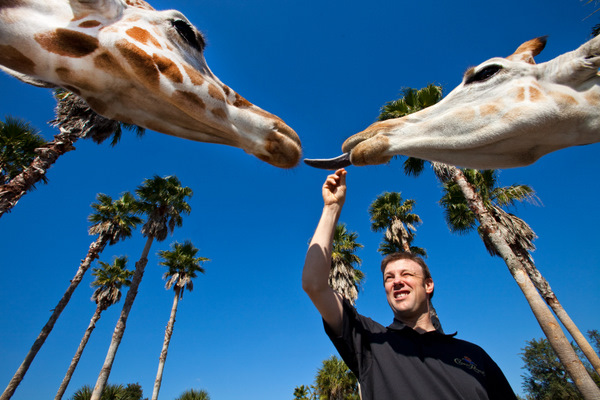
You think it's easy being a NASCAR driver? Hey, how do you feed a giraffe? How tall is that ladder, Matt? (Photo: Getty Images for NASCAR)
In the late 1970s, when CBS actually started carrying four Cup events live each season, that was considered a major breakthrough. The 1979 Daytona 500, live wire-to-wire – then a first -- was historic, and Cale Yarborough made it all the more so, duking it out with the Allison brothers after that last-lap crash, carried around to the country to a captive audience snowed in by a blizzard.
That helped prompt ESPN to the scene (with a good push by R. J. Reynolds), though NASCAR track promoters then were surprisingly leery of live TV, fearing it would hurt their gate.
But the opposite, of course, occurred. Just consider the impact of the History Channel's recent 'Madhouse' series on vintage quarter-mile Bowman Gray Stadium's attendance....
With live TV NASCAR's reach expanded throughout the country....which in turn created demand for tracks in new markets, prompting the construction boom of the late 1990s.
Now newspapers are all but dead, and NASCAR is covered so widely by TV, not just on race days but during the week too.
And now it's the 'social media' trend.
"When TV first came into this sport, there wasn't a lot of money...but it helped expand the base of fans," Hunter says.
"Still, newspapers, until the advent of the computers, were the foundation of NASCAR's coverage. I can remember John Radosta, from the New York Times, covering six to eight races a year ( http://nyti.ms/d15a8i )...and Shav Glick, of the LA Times, covered six or so races a year ( http://bit.ly/ayF4Pc )...and that all helped legitimize our sport.
"Then all of a sudden the computer age hit, and it changed everything.
"There are so many sites now....
"And then the newspapers, as businesses, were once making 20 or 30 percent profit, and suddenly – Zap! -- they weren't getting that any more.
"With the cutbacks, we have probably only a third of the newspapers covering our sport that were covering it just five years ago."
Ah, now this looks like more fun for a Daytona 500 winner (Photo: Getty Images for NASCAR)
Some of the surprising cuts – the Dallas and Fort Worth papers, the Baltimore paper, the Raleigh and Richmond papers....even Charlotte no longer has a full-time NASCAR reporter.
While newspapers generally botched the internet business, others moved into the void: "And now we have what we call 'citizen journalists....' all these sites that just popped up," Hunter says. "It's not just 'ESPN.com' or 'Mikemulhern.net,' it's 'Goracing.com,' 'Laidbackracing.com.'
"You can do your own deal.
"In one sense that's good, because it exposes the sport to a bigger audience. On the other side, there are no rules; there isn't the legitimacy of the old-time newspaper, where you had to answer to an editor."
Newspapers themselves have not only scrapped reporters like so much garbage but some have even, in a twisted turnaround, started 'outsourcing' articles, buying stories virtually right off the street, for as little as $5 each ( http://bit.ly/aPEQrD ).
"It's a whole new media world out there," Hunter says, perhaps with a shake of his head.
And Hunter, NASCAR as a company, and NASCAR's 23 tracks, and all the sport's teams (and sponsors) have to figure out how to deal with the changing media landscape...which is not just a Saturday-Sunday-Monday problem, but also a significant issue throughout the entire season.
Of course it's not just a NASCAR issue, but an issue for everyone from General Motors to Ford to Dodge to Toyota, and all the various other sponsors, which are trying to get their marketing messages out to the world.
No old-school NASCAR hack here. Fox' Krista Voda is one of the new media changing the face of stock car racing (Photo: Getty Images for NASCAR)
The media shakeup broke in earnest in the summer of 2007, when newspapers across the country began firing journalists en masse.
NASCAR CEO Brian France took the issue so seriously that in the summer of 2008 he delivered a speech to the Associated Press Sports Editors Association imploring newspapers not to drop NASCAR specialists: "We understand our sport can be expensive to cover, with race weekends lasting four days, requiring rental cars and hotel rooms. Budgets are tough to deal with. But we urge you to think twice when it comes to making decisions that affect NASCAR beat coverage. Don't get me wrong; we love the coverage the Associated Press provides. But we also feel like your readers deserve a local voice, a dedicated beat writer who can truly bring NASCAR home and make it relevant to them. Please . . . Keep your NASCAR writers."
That fell on deaf ears.
Newspapers continued chopping jobs.
And perhaps most pointedly, David Poole, the Charlotte Observer's NASCAR beat reporter, died suddenly a year ago, however the paper has declined to fill that job.
Jeff Gordon: NASCAR 101? (Photo: Getty Images for NASCAR)
So what have NASCAR and its track promoters done?
Simple – they've launched a major coast-to-coast marketing campaign in the opening weeks of the season, hauling drivers all around the country for high-profile appearances.
If newspapers don't send reporters to the races any more, well, NASCAR will just take the drivers to the various cities themselves:
Daytona 500 winner Jamie McMurray spent the rest of that February week marketing for NASCAR in San Francisco and New York.
Jeff Burton's pit crew was on the Fox and Friends morning TV show.
And a few weeks ago NASCAR had a platoon of drivers working the markets: Kurt Busch flipping hamburgers at the Varsity in Atlanta, Matt Kenseth bowling with the media in Dallas, Kasey Kahne was in a paintball war in Richmond, Jeff Gordon was in a third-grade classroom at Martinsville, Va., Kasey Kahne was 'rock-climbing' in Bristol, Va., Matt Kenseth was feeding giraffes in Tampa.....
You think it's easy being a stock car driver?
It's hard to imagine Curtis Turner doing any of this. Ol' Curtis, who worked hard to live up to his line "I didn't win every race, but I never lost a party."
Or was that Tim Richmond....
Hey, Kurt, how about one of those 'secret menu' burgers? Oh, but this isn't IN-N-Out, is it? (Photo: Getty Images for NASCAR)
The old 'media blitz' of a market – with a star driver and track promoter in a car driving from one media outlet to the next -- isn't quite the same. NASCAR promoters do it all high-tech now.
"I can remember, in the old days, we'd do a few tapes and sent them to TV stations, which they'd rarely use, because the quality was so poor," Hunter said.
"Now we do satellite media tours from each track; a driver may do 10 interviews with 10 different television stations from around the country, in an hour. Los Angeles, Denver, New York....and each station gets to ask its own questions."
However NASCAR still uses driver appearances to a maximum. "The more we can reach out and make our athletes accessible, the better off we'll be," Hunter says, pointing to Tony Stewart's day-long PR appearance in Charlotte last week.
Newspapers aren't the only media changing. So is local TV: "Local sports used to be five or six or seven minutes of the broadcast," Hunter says. "Now it's two minutes....and we're lucky if we can get a 30-second pop on a local TV channel."
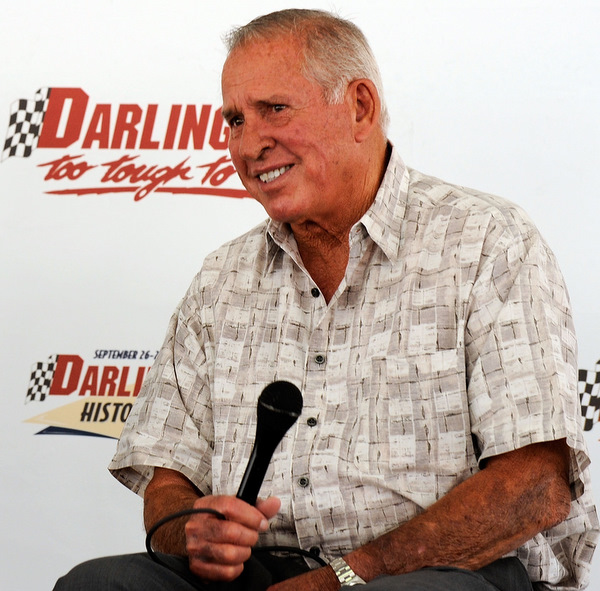
David Pearson: the best racer at Darlington, with 10 wins and seven seconds...and the man some consider the best driver ever in NASCAR, a three-time tour champion with 105 tour wins (Photo: Getty Images for NASCAR)
"ESPN does a great job for us," Hunter says. "Plus we have regular programming in ESPN and Fox, which really helps us on a national basis.
"Our broadcast partners run spots – for tickets or image – which helps our tracks."
Still getting arms around the internet isn't easy, not for anyone really.
"Marketing has certainly changed, because the marketing avenues are so much greater than they used to be, especially with the internet," Hunter says.
"There is so much to hit, when you consider what you want to advertise.
"It's very difficult to come up with an advertising plan for a race track today.
"First, you have to know your audience."
And many tracks have decidedly different audiences, different demographics.
Another problem today – fans these days, because of the economy, aren't going to as many races as they used to go to. And they are also cutting down on the distance they'll drive to get to an event.
"When I was here seven or eight years ago, one place we used to sell a lot of tickets was in the Northeast....that's a thousand miles from here," Hunter said.
"But that number is shrinking, in part because of New Hampshire (Motor Speedway), and the cost of gas and hotels.
"So we've had to revolutionize the way we think when it comes to marketing a race."
Part of the thinking is to promote more at the grassroots, something that R.J. Reynolds, when it was in the sport, pushed heavily, partly because that saturation marketing is really rather inexpensive, but remarkably effective -- in marketing continuity over a season.
"As the money gets bigger and the sport grows, it's easy to forget what got you there," Hunter says. "Obviously we can't sanction all 750 or 800 short tracks in the country. But we've got a heavy involvement in that part of the sport, and we're concentrating on the Home Track angle, promoting our 60 or so weekly tracks.
"Joey Logano, Denny Hamlin, Jeff Burton, after all, all came from our 'home tracks.'
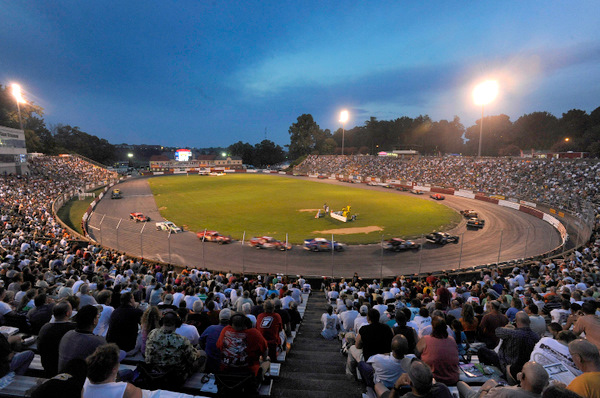
The Madhouse: Bowman Gray Stadium in Winston-Salem NC, which first opened with NASCAR in 1949 and once hosted annual Cup events on the flat quarter-mile, still packs 'em in. Grassroots promotions like this are important, as R.J.Reynolds showed during its 35 years in NASCAR (Photo: Getty Images for NASCAR)
"And Bowman Gray (Stadium, in Winston-Salem, N.C.) having that TV show (History Channel, 'Madhouse, http://www.history.com/shows/madhouse ), man, that was great," Hunter says. "Some of that was hokey 'reality tv,' but I've known people who have raced there for years. And that track is a great cross-section of what weekly racing is all about. And it still draws great crowds.
"I hope they continue that TV series....because it brings a whole new group of fans...."
That History Channel series prompted three busloads of fans to come all the way from Phoenix, Arizona, for the Bowman Gray season opener a few weeks ago. ( http://bit.ly/clRNGR )
Just keeping up with all the various marketing and promotion angles this sport's promoters are throwing out there can be daunting. And we haven't delved into the whole 'charity' aspect, like upcoming 'NASCAR Day,' Bruton Smith's Speedway Children's Charities, and Kyle Petty's annual cross-country charity ride ( http://bit.ly/ave9mP ) for his Victory Junction Gang camp (just concluded).
But then the basic NASCAR marketing game plan is pretty simple, Hunter says: "Anything we can do to keep the sport in the news on a daily basis."
[Note: You can use Twitter as an easy headline service for mikemulhern.net stories, with our instant Tweets to your mobile as soon as our newest NASCAR story is filed. And mikemulhern.net is mobile-friendly for viewing. You can also use the orange RSS feed button as a quickie headline service on your laptop or home computer for mikemulhern.net stories, by creating a Live Bookmark RSS feed on your web browser's toolbar. Or you can create a Google Alert for mikemulhernnet.]
What these guys go through during their off-days to promote the sport....Joey Logano on a Geoff Bodine bobsled run (Photo: Getty Images for NASCAR)
© 2010-2011 www.mikemulhern.net All rights reserved.
Web site by www.webdesigncarolinas.com







Wow, best NASCAR article I've
Wow, best NASCAR article I've read all year. That was a great piece. Thanks!
sure....hunter's got some
sure....hunter's got some good stories....and you ought to hear the ones we can't write lol....
Best NASCAR article I've read
Best NASCAR article I've read for some time. Nice job, great info, and thanks for the read.
and thank you.....and then
and thank you.....and then there was the time that hunter and me and a couple more journalists decided to camp out talladega weekend down somewhere outside the first turn....but i'd better not go there (lol).....
A great article...thank you!
A great article...thank you! I'm a younger fan (age 25) but very traditional, and I wish I were around during the earlier days of the sport. Regarding journalism itself, I think Nascar definitely lost a big piece of the pie when we lost David Poole last year.
i agree that nascar
i agree that nascar journalism has lost a lot in just the last two or three years....david was a big, big voice, and we used to have a dozen like him, like gerald martin and benny philips and ben blake and sandy mckee and shav glick and a host more....we're fortunate to have jenna doing the AP stuff, and she's the best they've ever had....but still it's like having only one reporter covering the white house. we need more voices. and TV, well, there are some good people there, but to be honest, we have to remember their companies are paying millions of dollars for the right to play the game. i'm afraid the sport of nascar racing needs more....brian france i think realizes that, but it's hard to figure out how to deal with it all. maybe a 'nascar racing' website with all the voice -- and not just the PC sites.....
Great story Mike. Reminds me
Great story Mike. Reminds me of when I used to work with the late Gerald Martin @ The Raleigh News & Observer. A real nice guy and a great storyteller. Back in the late 70's, 80's...I couldn't wait to read the N&O on Mondays, just to see what Gerald had to say on the past race and to later work side by side with him was such an honor.
you're right about
you're right about Gerald....that's what we've all missed in this newspaper push for just AP. the personal touch. the sport has lost a lot, and greedy/poor management by newspapers is to blame. sure, AP can handle the news....most of the time. but the twists and turns and sidebars, that's what newspapers used to provide....all the context we sorely need. at least that's what i'm trying to provide on mikemulhern.net.....
thanks...
Nice article,I must comment
Nice article,I must comment on the movie poster "Thunder In Carolina" When I was a young boy growing up I saw this movie and thought it was the greatest movie about stock car racing. being a northerner I dreamed about heading to the south to see real stock car racing. I still remember a few lines from the movie, one which said peanuts were not allowed in the pits.....and I remember Alan Hale telling Rory Calhoun how to drive into the turns...."go in low, come out high" I have been a fan ever since. I have managed to attend a number of races in the south, yet it took until I was 48 years old. Wish I had gone sooner.
i've been looking for a copy
i've been looking for a copy of that, ever since last weekend when i stumbled across it....
Post new comment